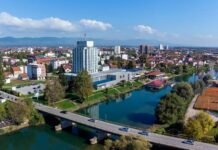During Montenegro’s 2023 presidential elections, voters aged 18 to 34 turned out in nearly half the proportion of the national average in the first round. This alarming statistic points to a deeply rooted issue of low political engagement among young people. Although they make up a significant portion of the electorate, youth are increasingly absent when it comes to voting, participating in public debates, or engaging actively in political life.
Why is that the case? One of the key reasons is political illiteracy – a lack of understanding of political processes, institutions, rights, and responsibilities. Without political literacy, young people struggle to make informed decisions, hold leaders accountable, or initiate change. And without youth who know, want, and are able to participate in democratic life, Montenegro risks having a democracy that is formal in structure but lacking in substance.
Political literacy is not just about knowing who the prime minister is or how Parliament functions. It involves understanding political processes, citizens’ rights and obligations, and the ability to critically assess political information. For young people who are inheriting society and determining its future, political literacy is a tool for active and responsible participation.
Without it, democracy remains a shell – citizens fail to use the mechanisms the system offers, avoid decision-making processes, and become passive observers rather than active participants.
Civic education is formally included in Montenegro’s school curriculum, but its implementation is fragmented. In many high schools, it is an elective subject with little room for practical activities such as election simulations, debates, local projects, or learning about government institutions. Many students finish school without a clear understanding of who makes decisions, how the system works, or what it means to be a politically responsible citizen.
The internet and social media are the main sources of political information for young people. While they allow quick access to news, they also make youth vulnerable to misinformation and manipulation. Mainstream media are often politically polarized, and alternative sources are not always reliable. Young people lack the tools to distinguish credible sources from biased or false information, further eroding their trust in politics.
Youth participation in political life in Montenegro remains worryingly low — not only in terms of voter turnout, but also in terms of joining political parties, NGOs, or public consultations. While they occasionally organize protests and express dissent, those voices often lack political weight and fail to influence decision-making. On social media, we see waves of activism through likes, stories, and posts – but this energy rarely transforms into institutionalized forms or long-term strategies. The potential is there, but without systemic support and space for serious political participation, young people remain on the margins of decision-making.
Young people are often subject to political manipulation through sensationalist headlines, spin, and biased reporting. In a society where media are politically influenced, distinguishing truth from propaganda is difficult. The lack of media literacy only deepens the problem.
Many young people express disappointment and distrust in the political system. There’s a widespread belief that “nothing ever changes,” that “all politicians are the same,” and that their voice doesn’t matter. This apathy leads to passivity and withdrawal from political life.
Youth we spoke with said that political literacy is mostly acquired informally and depends on personal interest, while quality political education is largely reserved for students of political science. Participants agreed that political literacy should be a mandatory subject in schools, as most young people only seriously encounter politics at age 18 when they gain the right to vote.
One student from the Faculty of Political Sciences emphasized that young people increasingly distrust politicians. She believes that a lack of information from political leaders is a key reason for this distrust and the resulting lack of motivation among youth to engage politically.
In Montenegro, young people are often present on electoral lists merely as decoration, not as true agents of change. They are nearly absent from key decision-making positions. Although the law doesn’t limit youth activism, the state framework provides little incentive or opportunity for their political involvement. The voices of young people are often drowned out in favor of traditional political figures and narratives. Older members dominate political parties, and youth interests rarely feature prominently on the political agenda. This fosters the feeling that young people “don’t matter,” which further discourages engagement.
Compared to other countries in the region, youth political engagement in Montenegro is similar – low turnout, limited trust in institutions, high political polarization. Still, there are examples in the region that can serve as inspiration. In Serbia and Croatia, for instance, student protests have led to concrete political changes. In Slovenia, youth have successfully brought climate policy to the forefront.
In Montenegro, the student initiative “Kamo śutra” shows that young people are ready to take responsible action in response to serious social and institutional failings. Sparked by the tragedies in Cetinje and other social issues, their demands include political accountability, security sector reform, better mental health support, and the return of civic education with a peace-focused agenda. This group illustrates how youth energy can translate into concrete demands, but the challenge remains how to channel that energy into sustainable institutional mechanisms and long-term political change.
To improve political literacy and active youth participation, action is needed on multiple fronts. First, civic education must be brought to life – it cannot be reduced to dry theory and passive learning. By introducing interactive methods such as election simulations, debates, institutional visits, and hands-on projects, students can gain a real understanding of the political system and their role within it.
Equally important is the strengthening of digital literacy, by including media and information education in the school system. This would equip young people to identify misinformation, critically analyze political messaging, and build resilience against manipulation.
Beyond education, youth must be actively involved in public life. Their participation in local councils, public consultations, and budget discussions should not be the exception, but the rule. Creating space for their voices and enabling political mentorship within parties and institutions can significantly enhance their sense of belonging and responsibility.
Finally, legal support is essential. Decision-makers must show political will to truly give young people a seat at the table. Introducing youth quotas on electoral lists, formally supporting youth councils, and creating institutional pathways for youth inclusion in decision-making are concrete steps toward a political system that doesn’t ignore, but empowers, the next generation.
Political literacy is not a luxury, it is the foundation of a functioning democracy. Young people who understand the system, recognize manipulation, and know how to fight for their rights are a force capable of transforming society.
As one student from Podgorica stated: “I don’t want to be just a number on the voter list – I want my voice to mean something.”
It’s time for young people in Montenegro to move from spectators to shapers of the future. Because democracy is not a finished product – it’s a process that depends on every citizen, especially those just entering public life.
An informed young person is a free person. And a free person can change the world.
By: Milica Đokđurić













